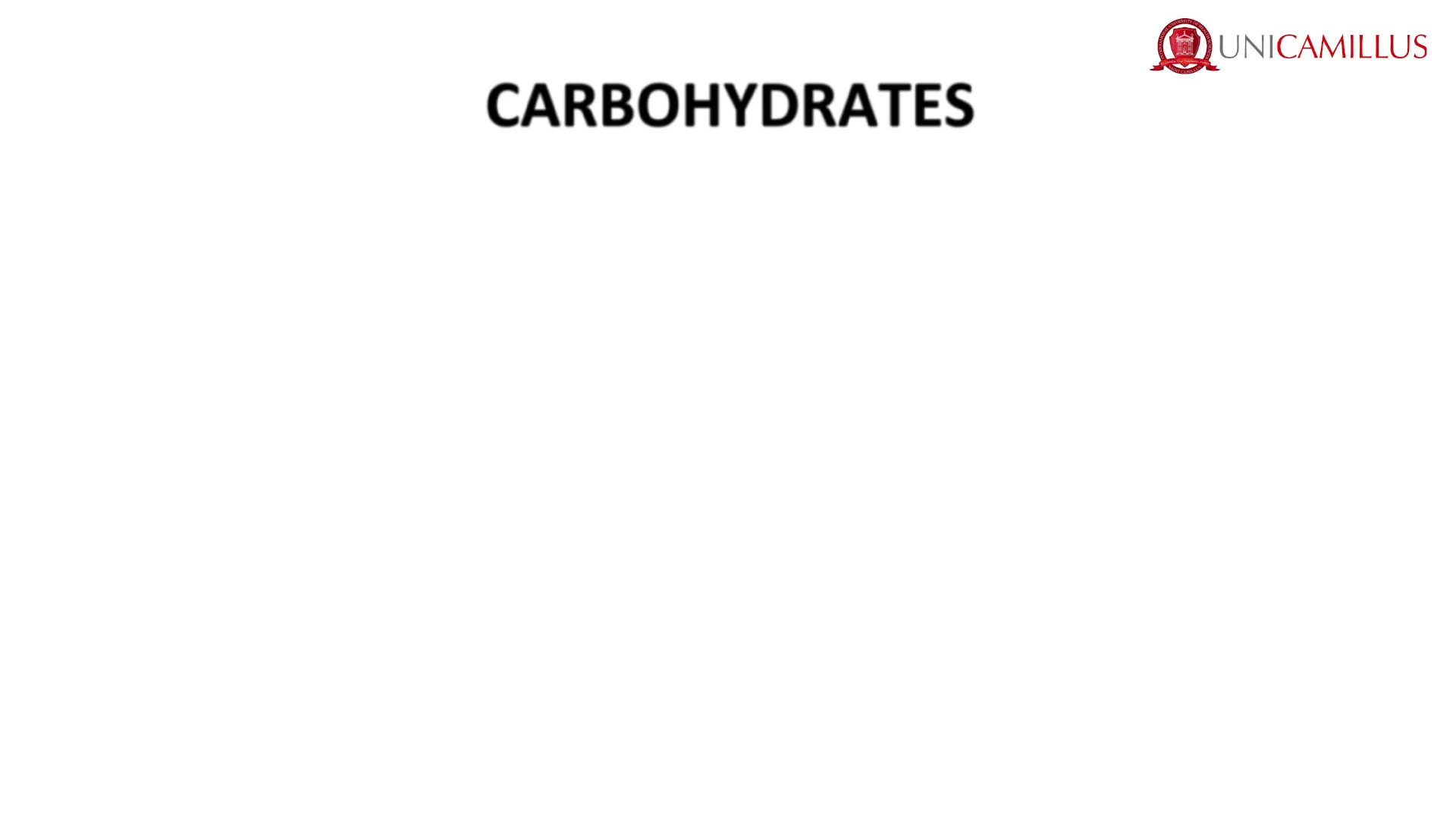Carbohydrates Part 1: Structure and Chirality in Biology
Slides from Unicamillus about Carbohydrates Part 1. The Pdf introduces carbohydrates, highlighting their importance as fuel and structural components of cells, focusing on glyceraldehyde and chiral carbons. The Pdf provides a detailed overview for university-level Biology students.
See more25 Pages


Unlock the full PDF for free
Sign up to get full access to the document and start transforming it with AI.
Preview
Carbohydrates: An Introduction
For years, the study of carbohydrates was considered less exciting than many, if not most, topics of biochemistry. Carbohydrates were recognized as important fuels and structural components but were thought to be peripheral to most key activities of the cell. This view has changed dramatically in the past few years. Indeed, rather than being mere infrastructure components, carbohydrates supply details and enhancements to the biochemical architecture of the cell, helping to define the functionality and uniqueness of the cell.NTYRNATION ALTH SC UNICAMILLUS
Carbohydrate Definitions
Carbohydrates Saccharides Sugars They are POLYFUNCTIONAL COMPOUNDS; in fact, there are HYDROXYL GROUPS and either hydroxyl groups and aldehydes or hydroxyl groups and ketone groups.
- POLYHYDROXYALDEHYDE: HYDROXYL GROUP(S) + ALDEHYDE GROUP(S)
- POLYHYDROXYCHETONE: HYDROXYL GROUP(S) + KETONE GROUP
The term SUGARS is utilized just for those carbohydrates soluble in water and sweet in taste.NTYRNATION ALTH SC UNICAMILLUS
Carbohydrate Functions
Source of Energy
Glucose is the principal fuel of metabolism, supplying energy to all living cells, both plants and animals.
Storage Form of Energy
Also it serves as the storage form of energy (starch in plants and glycogen in animals) to satisfy the immediate energy demands of the organism.ALTH SC NTYRNATION UNICAMILLUS
Structural Component
They form structural components of many organism :
- the fibers of plants (cellulose)
- exoskeleton of some insects or crustaceans (chitin)
- the cell wall of microorganism (bacteria)
RNA and DNA Constituent
CONJUGATED WITH PROTEINS AND LIPIDS INVOLVED IN CELL-CELL INTERACTION and RECOGNITION EVENTSUNICAMILLUS
Chemical Features of Carbohydrates
All of these functions are made possible by their CHARACTERISTICS CHEMICAL FEATURES:
- v The existence of at least one, or more, asymmetric center
- v The ability to exist either in linear or ring structure
- v The capacity to form polymeric structures by means of glycosidic bonds
- The potential to form multiple hydrogen bonds with water, or other molecules, in their environmentIndeed, the empirical formula for many carbohydrates is : NTYRNATION ALTH SC UNICAMILLUS (CH2O)n n ≥3
Monosaccharides: Simple Sugars
The simplest form is represented by MONOSACCHARIDES (simple sugars with multiple -OH groups) These simple sugars serve not only as fuel molecules but also as fundamental constituents of living systems. Their classification is:
- based on the number of carbon atoms (3, 4, 5, 6, 7): TRIOSE, TETROSE, PENTOSE, HEXOSE and HEPTOSE Example : HEXOSE (CH2O)6 > C6H1206
- · based on the functional group: .Aldoses = have an aldehyde group at C1 ·Ketoses = have a ketone group at C2MONOSACCHARIDES NTV.RNATION ALTR SC UNICAMILLUS
Aldoses and Ketoses
O Aldoses R -C ~H H O C H-C-OH HO-C-H 1 H-C-OH H-C-OH CH2OH D-glucose aldohexose Ketoses R - C -R' O CH2OH C=0 HO-C-H H-C-OH H-C-OH CH2OH D-fructose ketohexoseUNICAMILLUS
Complex Carbohydrates
DISACCHARIDES = 2 monosaccharides covalently linked. OLIGOSACCHARIDES = from 2 at up to 10 -15 monosaccharidec residues covalently linked. POLYSACCHARIDES (glycans) = polymers consisting of long chains of monosaccharidec or disaccharidic units. (M.W. at up to 106 dalton) They are generally tasteless (non sugars) and form a colloidal solution with water.
- HOMOPOLYSACCHARIDES (monosaccharides of a single type)
- HETEROPOLYSACCHARIDES (monosaccharides of 2 or more different types, or their derivatives)NTV.RNATION ALTH SC UNICAMILLUS
Carbohydrate Classification Summary
MONOSACCHARIDES ALDOSES KETOSES SUGARS DISACCHARIDES NON BRANCHED crystalline substances that dissolve in water OLIGOSACCHARIDES CARBOHYDRATES HOMOPOLYSACCHARIDES BRANCHED (monosaccharides of a single type WITH MORE THAN 10 IDENTICAL MONOSACCARIDES) NON BRANCHED POLYSACCARIDES polymers consisting of long chains of monosaccharidec or disaccharidic units Are tasteless and form a colloidal solution with water. HETEROPOLYSACCHARIDES (monosaccharides of 2 or more different types, or their derivatives single type WITH MORE THAN 10 IDENTICAL MONOSACCARIDES) BRANCHEDUNICAMILLUS
Monosaccharide Nomenclature and Asymmetric Carbons
The nomenclature of monosaccharides is also directly related to the configuration of each asymmetric carbon.
Important Concepts: Asymmetric Carbon
1) Asymmetric Carbon: o When it is attached to 4 different atoms or groups. A C X B Y CHO CHO H) OH H OH CH2OH CH2OH A Chiral Carbon C X B X NO Chiral CarbonUNICAMILLUS
Glyceraldehyde Configurations
The simple aldotriose glyceraldehyde, it has only 1 asymmetric C (C*), we can have 2 different configurations: D & L CHO HD C-OH * HO *C-H CH2OH CH2OH D-glyceraldehyde L-glyceraldehyde CHO CHO H-C-OH HO C-H CH2OH CH2OH H-C-OH HO-C-H Fischer Projections r I CHO CHO CH2OH CH2OH 1 H-C-OH HO-C-H 1 CH2OH D L CH2OH CHO CHO I * I D-glyceraldehyde L-glyceraldehyde CHONTYRNATION ALTH SC UNICAMILLUS
Dihydroxyacetone and Glyceraldehyde Isomers
CH2OH I C=0 NO CHIRAL CARBON CH2OH Dihydroxyacetone CHO CHO I H-C-OH HO-C-H CH2OH CH2OH D-glyceraldehyde L-glyceraldehyde 1UNICAMILLUS
D and L Isomers in Carbohydrates
In carbohydrates with more than 1 chiral carbon, D or L refers to the position of the oxydrylic group in the asymmetric C farthest from the functional group (aldehydic or ketonic) (D = OH group is on the right ) Most naturally occurring are D isomers. O H O H C C HO-C *- H 1 H-C* OH 1 HO - CK- H I H-C *- OH I H-C-OH HO -C"-H 1 * H -C-OH HO-C*H H-EC-OH H CC -OH HO -CPH CH2OH CH2OH CH2OH D-fructose D-glucose L-glucose CH2OH I C=0UNICAMILLUS
Enantiomers and Stereoisomers
The ENANTIOMERS are stereoisomers with molecules that are not superimposable mirror images O H O H C C 1 H -C-OH 1 HO -C-H 1 HO -C-H 1 H -C-OH H-C-OH - HO -C-H 1 H -C-OH HO-C-H I CH2OH CH2OH D-glucose L-glucose The aldoses have 4 asymmetric centers (24), > there are 16 stereoisomers (8 D-hexoses and 8 L-hexoses). Hexoses have the same chemical formula C H1206 but exist different stereoisomers having exclusive names: GLUCOSE, MANNOSE, GALACTOSE, etc.NTYRNATION ALTH SC UNICAMILLUS
Epimers
EPIMERS TWO SUGARS DIFFERENT IN CONFIGURATION OF ONLY ONE CHIRAL CARBON 1 CHO 1 CHO 1 CHO I HO -- C-H H -- C-OH H -- C-OH HO-C-H 3 HO-C-H 3 3 HO-C-H I H-4C-OH H-4C-OH HO -- C-H I I 5 H -- C-OH H -- C-OH H -- C-OH 6 6 6 CH2OH CH2OH CH2OH D-Mannose (epimer at C-2) D-Glucose D-Galactose (epimer at C-4) -The ALDOSE family NTV.RNATIONSE UNICAMILLUS
Aldose Family
Three carbons Four carbons Five carbons H 0 H 0 H ,0 H 0 1 1 C C C 1 H-C-OH HO-C-H H-C-OH HO-C-H - H-C-OH H-C-OH HO-C-H HO-C-H - H-C-OH H-C-OH H-C-OH H-C-OH CH2OH - CH2OH CH2OH CH2OH D-Ribose D-Arabinose D-Xylose D-Lyxose Six carbons H H 0=0 0=0 H 0 H O H H H C C 0 -C HO-C-H H-C-OH HO-C-H H-C-OH HO-C-H H-C-OH HO-C-H H-C-OH H-C-OH HO-C-H HO-C-H H-C-OH H-C-OH HO-C-H HO-C-H H-C-OH H-C-OH H-C-OH H-C-OH HO-C-H HO-C-H HO-C-H HO-C-H H-C-OH H-C-OH H-C-OH H-C-OH H-C-OH H-C-OH H-C-OH H-C-OH CH2OH CH2OH CH2OH CH2OH CH2OH CH2OH CH2OH CH2OH D-Allose D-Altrose D-Glucose D-Mannose D-Gulose D-Idose D-Galactose D-Talose H 0=0 H-C-OH HO-C-H H-C-OH H-C-OH H-C-OH CH2OH CH2OH CH2OH D-Glyceraldehyde D-Erythrose H 0=0 C 1 1 - -C 0=0 0=0 0=0 O 0= H O=0 0=0 H-C-OH - - mnemonic trick: "all altruists gladly make gum in gallon tanks". 1 H O D-ThreoseThe KETOSE family NTV.RNATION UNICAMILLUS
Ketose Family
Three carbons Four carbons Five carbons CH2OH CH2OH C=0 C=0 CH2OH CH2OH 1 C=0 C=0 H-C-OH H-C-OH CH2OH CH2OH CH2OH Dihydroxyacetone D-Erythrulose D-Ribulose D-Xylulose Six carbons CH2OH C=O CH2OH CH2OH I C=O C=O - H-C-OH HO-C-H H-C-OH HO-C-H H-C-OH H-C-OH HO-C-H - H-C-OH H-C-OH H-C-OH - H-C-OH CH2OH CH2OH CH2OH CH2OH D-Psicose D-Fructose D-Sorbose D-Tagatose Ketohexoses have 3 chiral centers and, consequently, 8 possible stereoisomers (23), but only the 4 D-isomers are present in nature H-C-OH HO-C-H H-C-OH CH2OH HO-C-H - -0-UNICAMILLUS
Cyclic Structures of Monosaccharides
Starting with 5- and 6-carbon-atom monosaccharides, the structure of carbohydrates is no longer linear, open, but closed-loop (the predominant forms of ribose, glucose, fructose, and many other sugars in solution) Rather, the open-chain forms of these sugars cyclize into rings. This is possible because an intramolecular semiacetylation reaction (having zero-order kinetics) takes place that leads to the formation of a stable semiacetal. The chemical basis for ring formation is that an aldehyde can react with an alcohol to form a hemiacetal. 0 HO OR' C + HOR' C H H R R Aldehyde Alcohol Hemiacetal Similarly, a ketone can react with an alcohol to form a hemiketal. 0 HO OR" .C + HOR" C R R' R 'R' Ketone Alcohol HemiketalUNICAMILLUS
Glucose Cyclization: Pyranose Formation
The open-chain form of glucose cyclizes when the C-5 hydroxyl group attacks the oxygen atom of the C-1 aldehyde group intramolecular hemiacetal. The resulting cyclic hemiacetal, a six-membered ring, is called PYRANOSE because of its similarity to PYRAN. CH 2OH OH H H OH H HO OH H OH H „¢- 2 5 -OH «-D-Glucopyranose H-C- HO U H H 1 OH = 4 C H C- H C- OH 1 4 HO 3C C 2 C -OH H OH CH 2OH H -O OH H OH H HO H H OH ß-D-Glucopyranose O H I TC 6 CH2OH -OH H 3 =0 H 5 6 CH 2OH D-Glucose (open-chain form)NTV.RNATIONS ALTH SC UNICAMILLUS
Anomers and Anomeric Carbon
6CH2OH 6 CH2OH 5 O H H OH H 4 OH H * 1 4 OH H 1 OH OH OH H 3 2 3 2 H OH H OH a-D-Glucopyranose 5 O H H * 1 L B-D-Glucopyranose Cyclization of HEXOSE produces a new asymmetric center at the C1. The 2 stereoisomers are called ANOMERS, a and B, and C1 becomes the ANOMERIC CARBON.
- . Anomeric carbon alpha = When the hydroxyl group -OH of the anomeric carbon (C 1) is below the plane of the molecule (as opposed to the -CH2OH group)
- . Anomeric carbon beta = when the -OH hydroxyl group of the anomeric carbon (C 1) is above the plane of the molecule (on the same side as the -CH2OH group)ATERNAIM ALTH SC UNICAMILLUS
Fructose Cyclization: Furanose Formation
The open-chain form of fructose cyclizes to a five-membered ring when the C-5 hydroxyl group attacks the C-2 ketone to form an intramolecular hemiketal. The five-membered ring is called a FURANOSE because of its similarity to FURAN. 1 O CH 2OH 6 HOH2C CH2OH OH 1 H .C 5 CH2OH H HO = 4C C H OH 3 C 2 HO O H-C-OH H OH H 6 CH 2OH D-Fructose (open-chain form) &-D-Fructofuranose (a cyclic form of fructose) O HO- C-H 3 OH H. H-C-OH HOH2C C 2STYRNA UNICAMILLUS
Fructofuranose Anomers
Also, for FRUCTOFURANOSE it is possible to distinguish the two ANOMERS and C2 * is the ANOMERIC CARBON. Also in this case :
- a -> OH below the ring
- B -> OH above the ring 1 HOH C CHOH O 2* H OH 1 1 H OH 3 OH H a-D-Fructofuranose